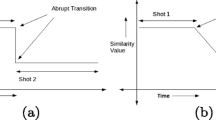Abstract
A key step for managing a large video database is to partition the video sequences into shots. Past approaches to this problem tend to confuse gradual shot changes with changes caused by smooth camera motions. This is in part due to the fact that camera motion has not been dealt with in a more fundamental way. We propose an approach that is based on a physical constraint used in optical flow analysis, namely, the total brightness of a scene point across two frames should remain constant if the change across two frames is a result of smooth camera motion. Since the brightness constraint would be violated across a shot change, the detection can be based on detecting the violation of this constraint. It is robust because it uses only the qualitative aspect of the brightness constraint—detecting a scene change rather than estimating the scene itself. Moreover, by tapping on the significant know-how in using this constraint, the algorithm's robustness is further enhanced. Experimental results are presented to demonstrate the performance of various algorithms. It was shown that our algorithm is less likely to interpret gradual camera motions as shot changes, resulting in a significantly better precision performance than most other algorithms.
Similar content being viewed by others
References
P. Bouthemy and F. Ganasia, “Video partitioning and camera motion characterization for content-based video indexing,” in Proc. ICIP, 1996.
L.-F. Cheong and K.-O. Ng, “Geometry of distorted visual space and Cremona transformation,” International Journal of Computer Vision, Vol. 32, No. 2, pp.195–212, 1999.
K. Daniilidis and M.E. Spetsakis, “Understanding noise sensitivity in structure from motion,” in Visual Navigation: From Biological Systems to Unmanned Ground Vehicles, Y. Aloimonos (Ed.), Lawrence Erlbaum Associates, New Jersey, 1997.
R.M. Ford, “Quantitative comparison of shot boundary detection metrics,” SPIE, Vol. 3656, pp. 666–676, 1999.
U. Gargi, R. Kasturi, and S. Antani, “Performance characterization and comparison of video indexing algorithms,” in IEEE Conference on Computer Vision & Pattern Recognition, Santa Barbara, California, USA, 1998.
A. Hampapur, R. Jain, and T. Weymouth, “Production model based digital video segmentation,” Multimedia Tools and Applications, Vol. 1, No. 1, pp. 9–46, 1995.
B.K.P. Horn and B.G. Schunck, “Determining optical flow,” Artificial Intelligence, Vol. 17, pp. 185–203, 1981.
V. Kobla, D. DeMenthon, and D. Doermann, “Special effect edit detection using VideoTrails: A comparison with existing techniques,” SPIE, Vol. 3656, pp. 302–313, 1999.
H.C. Liu and G.L. Zick, “Scene decomposition of MPEG compressed video,” in Proc. SPIE, Vol. 2419, pp. 26–37, 1995.
B.D. Lucas and T. Kanade, “An iterative image registration technique with an application to stereo vision,” in Proc. IJCAI, 1981.
J. Meng, Y. Juan, and S.F. Chang, “Scene change detection in a MPEG compressed video sequence,” in Proc. SPIE, Vol. 2419, pp. 14–25, 1995.
N.V. Patel and I.K. Sethi, “Video shot detection and characterization for video databases,” Pattern Recognition, Vol. 30, No. 4, pp. 583–592, 1997.
I.K. Sethi and N. Patel, “A statistical approach to scene change detection,” in Proc. SPIE, Vol. 2420, pp. 26–37, 1995.
A. Seyler, “Probability distributions of television frame differences,” in Proc. IEEE, Vol. 53, pp. 355–366, 1965.
S. Shahraray, “Scene change detection and content-based sampling of video sequences,” in Proc. SPIE, Vol. 2419, pp. 2–13, 1995.
S.M-H. Song, T-H. Kwon, and W.M. Kim, “On detection of gradual scene changes for parsing of video data,” in Proc. SPIE, Vol. 3312, pp. 404–413, 1997.
S. Uras, F. Girosi, A. Verri, and V. Torre, “A computational approach to motion perception,” Biological Cybernetics, Vol. 60, pp. 79–87, 1988.
A. Verri and T. Poggio, “Motion field and optical flow: Qualitative properties,” IEEE Trans. Pattern Analysis and Machine Intelligence, Vol. 11, No. 5, pp. 490–498, 1989.
B.L. Yeo and B. Liu, “Rapid scene analysis on compressed video,” IEEE Trans. Circuits Systems Video Technol. Vol. 5, pp. 533–544, 1995.
H. Zhang, C.Y. Low, and S.W. Smoliar, “Video parsing and browsing using compressed data,” Multimedia Tools and Applications, Vol. 1, pp. 89–111, 1995.
Author information
Authors and Affiliations
Corresponding author
Rights and permissions
About this article
Cite this article
Cheong, LF., Huo, H. Shot Change Detection Using Scene-Based Constraint. Multimedia Tools and Applications 14, 175–186 (2001). https://doi.org/10.1023/A:1011351316971
Issue Date:
DOI: https://doi.org/10.1023/A:1011351316971




